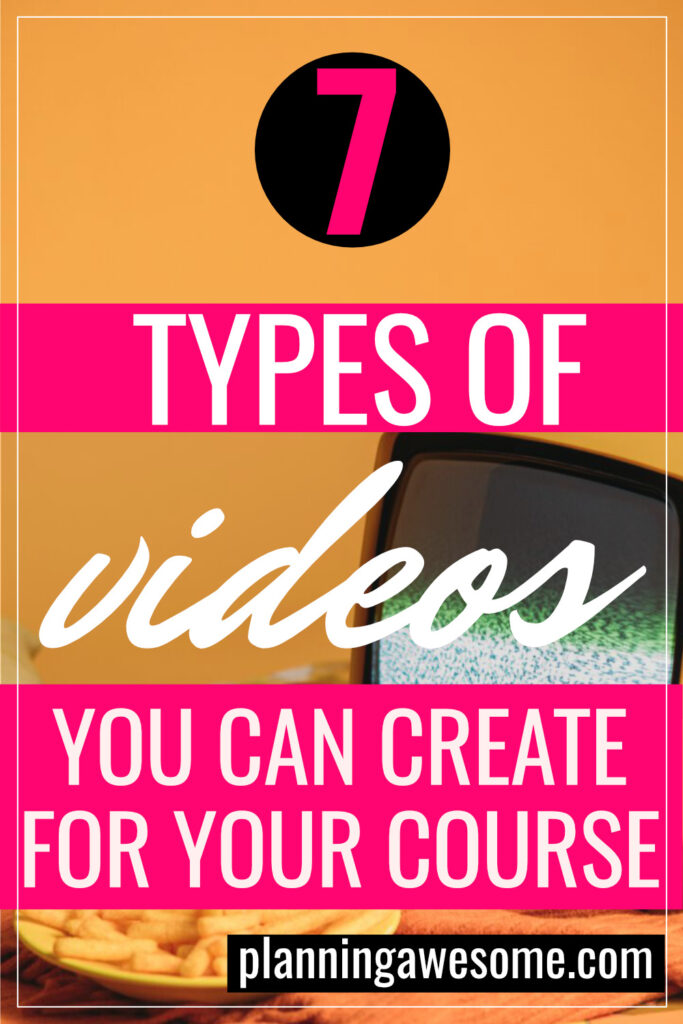7 Types of Videos You Can Create for Your Course

Online courses are versatile. They can be used to teach almost any subject, and you can reach an audience around the world. An online course can be a stand-alone training tool, a supplement to in-person teaching, or it can even be an alternative to some of our more traditional education formats. It doesn’t matter if you are a coach, teacher, or a business, you can easily use an online course to create a better education experience for your students, employees, or clients. If you are thinking about using an online course as a teaching tool, then you should consider different types of videos. Engaging videos can make a big difference in the quality of your online course. They allow your students to get to know you and the subject from the comfort of their own home.
So now you might be a little worried about videos. If you are camera-shy you might be wondering if you have to be on video. The short answer is no, you don’t really need to show your face on videos, however it would be nice for your audience to hear your lovely voice. I’m going to share some options with you to keep in your arsenal for videos… you know, in case you have a bad hair day when it’s time to produce your course content.
1. Talking Head / Newcaster Style Videos
This is the type of video you probably know best. It’s you. On camera from the shoulders up. You could be sitting or standing, but typically facing the camera and talking. I like to call these newscaster style because you’re dishing out information. You’re engaging your audience with your voice, facial expressions and body language (what you can show from the shoulders up), telling some wonderfully interesting stories or giving out that good information to your audience. I, personally, find these the most stressful, but probably the easiest videos to create for a course.
2. Interview Videos
In this type of video, you share the spotlight with a guest. You banter back and forth asking questions and waiting for a response from your guest. But if you are camera-shy the good thing about this type of video is that you get a break from the focus being completely on you. While your guest is speaking, you have time to freak-out internally while maintaining your composure for the camera. Guests usually do a great job, you just have to dole out interesting questions.
3. Recorded Webinar or Live Event Videos
Recorded videos from your webinars or live events give you the opportunity to reuse content in your course. Let’s say you gave an awesome talk 3 months ago. You prepared for months, all the topics were covered and you executed it flawlessly. Why not reuse that as part of your course? Typically, recordings are available for meetings in Zoom or virtual event platforms. If it was a live in-person event, get friendly with the event producers (or bring your own camera person) to grab a recording.
4. Tour Videos
In a tour video, you might want to show your audience a place that’s important to what they are learning. Interior decorators may show a tour of a home and say “here’s what you’ll be able to do after you take my course.” A mechanic might record a tour of shop that shows “once you learn the basics in this course, this is where you will be working.” A healer might simply show a tour of an outdoor setting, with a babbling brook to help her audience with a meditation practice. Basically, you will show a place instead of photos or just talking about it. These types of videos might add some needed context to what you’re teaching.
5. Animation / Explainer Videos
Animated videos often have characters doing interesting things on screen. They can illustrate what you are explaining in an amusing way and can be good for keeping your students engaged with the content. These types of videos don’t need characters though. You can also create them with interesting moving images, graphics and text that can provide a “mood” to what you are explaining with your content. For example, if your content is fun and exciting you can have some zippy, bouncy letters. If your content is more tempered (i.e., boring), you may have simple, slowly fading letters that present a more professional tone. The sky is the limit with animated videos.
6. Recorded Presentation / Screencast Videos
Screencasting or screen sharing videos are created by certain software that allows you to record what you are doing on your computer screen. You can create a video of you teaching how to use a website, work on a budget, check email, use Google – whatever your course requires. You can also record yourself walking through the slides for your lesson. For the camera-shy, this is a game changer. Your students can still hear your voice, and see your slides, but you don’t have to show your face!
7. Demonstration Videos
Demonstration videos show you doing what you are teaching. You could be sewing, cooking, martial arting, or surfing. Depending on exactly the skill you’re demoing, it could range anywhere from your full body far away (think horseback riding), or an up close view of your hands (think miniature painting).
Engaging video is important, perhaps a requirement for most online courses. I’ve provided you a number of video styles to think about. Use it to consider the types of videos you may want to include, not only depending on how comfortable you are in front of a camera, but also to provide variety in your course.




